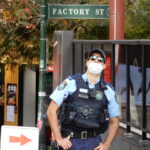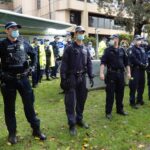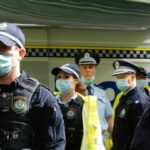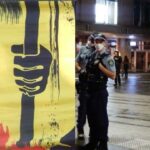Extreme COVID Law Enforcement Has Helped Fuel the Anti-Lockdown Movement
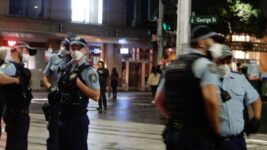
The recent use of non-lethal weapons on anti-lockdown demonstrators in Melbourne are the most extreme examples of the approach Australian government and its law enforcement agencies have taken to COVID-19 pandemic restrictions.
The onset of what’s now referred to as COVID policing hasn’t seen officers granted any extra powers to apply force, and nor has it seen any new weapons acquired to use during recent unrest, but it has produced a climate where officers have been emboldened to overstep the mark.
Policing public health issues has been shown to be counterproductive in the past, just think of the war on drugs.
Indeed, the focus on the vaccine by recent anti-lockdown protests in Melbourne suggests that attempting to enforce life-saving treatments upon people can make them wary.
Far-right provocateurs have been fuelling much of the antivax and anti-lockdown messaging circulating on the web. And the CFMEU and the ACTU have both stated this element has been long stoking what became the recent construction protests.
Former US president Donald Trump was one of the most prominent pandemic deniers in the early days of COVID. And YouTube banned Murdoch’s Sky News Australia from its platform for a week this year, due to its spreading misinformation about the virus that has claimed 4.55 million lives globally.
But it’s the heavy-handed policing approach to the global health crisis – that scientists had long warned was coming – which has left a space for conspiracies to thrive, as well as laid bare the issues within our societal systems that have led to health measures being delivered at point of gun.
A proactivist legal perspective
Melbourne Activist Legal Support (MALS) issued a statement on 22 August, outlining its concerns over Victoria police having used VKS Pepper Ball semiautomatic rifles to fire nonlethal rounds at anti-lockdown protesters the day prior.
MALS explained that Victoria police acquired these weapons – which have the ability to “blind, maim and leave permanent injury” – in 2016. And it asserts the acquisition of them is part of an ongoing “rise in coercive and excessive crowd control tactics” by police that it’s been tracking.
An independent legal organisation monitoring the policing of protests, MALS has also made clear that it does not “support actions, rhetoric or causes that are designed to undermine public health restrictions”, as it “acknowledges restrictions upon basic freedoms… are sometimes necessary”.
“We condemn the normalisation” of harmful nonlethal weapons used by police, along with the growing police arsenal, the legal organisation sets out in its statement.
“The increased use of weaponry as a crowd control mechanism sets a dangerous precedent” and risks the normalisation of their use at protests.
While it wasn’t the virus that provoked the use of these weapons, it was the overbearing policing of the pandemic that certainly provoked the protest that did. And it was the climate of COVID policing that encouraged the drawing of these weapons to be used upon citizens for the first time.
A two class lockdown
Up in NSW, the Berejiklian government has seen fit to take a similar approach to dealing with the COVID-19 virus.
In the early days of the pandemic, NSW police commissioner Mick Fuller was given free rein over the state’s entire response to the public health crisis.
During a 1 September budget estimates hearing, Fuller described the approach NSW police has been taking to COVID-19 as “treating the virus itself like a criminal”, which was a very concise way of summing up what has been transpiring in this state and down south of the border.
“Therefore, wherever the virus is, you will see an increased police presence,” the commissioner continued, which has been true to the extent that when the Delta strain of the virus hit less affluent multicultural communities in southwest Sydney, NSW police turned up with bells on.
Although, this wasn’t the case when the new variant of the virus first appeared in the wealthy WASP east of the city.
Following an initial laxed lockdown in Greater Sydney, when the virus hit the southwest, NSW police launched a “major high-visibility” operation, which was, weeks later, accompanied by army troops.
The initial deployment of extra police officers in the southwest, and the heightened restrictions that only that area was subjected to, was widely cited as having fuelled the ranks of the sizable anti-lockdown demonstration that took place in the Sydney CBD in late July.
Biosecurity policing
UNSW Faculty of Law senior lecturer Dr Vicki Sentas told Sydney Criminal Lawyers back in August that COVID policing is a form of security policing, which is a preemptive military style of law enforcement that acts on threats “before they materialise”.
“Across Australia, the approach to policing COVID has been classic high visibility, public order policing based on enforcing breaches of new criminal offences largely through hefty fines, directions, searches but also arrest and charge,” the academic explained.
Some of the early instances of NSW police enforcing public health measures in this state were absurd, with reports of people being fined over eating a kebab on a park bench or being approached while sitting in their car looking out at the beach.
However, it was under this enhanced street presence that encroachments began to occur. A paper Sentas co-authored late last year showed that over the three months to 15 June 2020, 45 percent of people approached by NSW police over a suspected COVID breach were subsequently searched.
And long after the initial lockdown in this state was lifted in late May last year, police were continuing to enforce a ban on public protest – often brutally – in October.
While down in Victoria, an officer assaulted a woman for not wearing a mask, a man with intellectual disabilities was swarmed by officers and kneed in the head, and the riot squad approach to anti-lockdown protests was first taken at Melbourne’s Queen Victoria Markets in September 2020.
A better way…
Just as scientists are warning that the planet is in the midst of a fast accelerating climate crisis, they were also warning that a pandemic of the scale now upon us – disease X, as they termed it – was likely on its way. And many scientists posit that we’re entering an age of pandemics.
Australian governments were well aware that such a situation could be nearing, as the framework of laws that allowed for the health measures that have been rolled out since the beginning of the pandemic, were passed in 2010 in NSW and two years earlier in Victoria.
However, the authorities didn’t empower citizens with the knowledge that such a crisis – which might involve lockdowns, as have occurred in the past, or a rush to develop and administer a vaccination – could be approaching.
None of this was ever thoroughly flagged with the general populace.
Instead, authorities choose to maintain the current power structures which rely on an enhanced police presence enforcing an uninformed public to adhere to life-preserving crisis measures, at the point when the shock of their onset can appear as a conspiratorial means of control.


